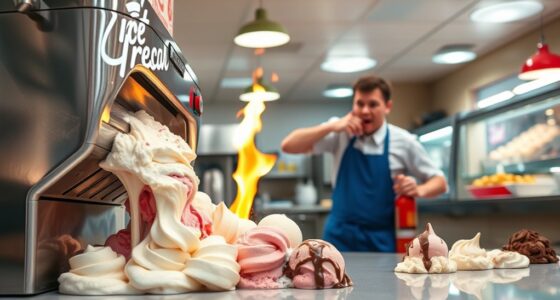Soft serve machines quickly produce airy, smooth treats by constantly freezing and aerating liquid mixtures, while batch freezers create denser ice cream at a slower pace, focusing on flavor and texture. Many think harder ice cream equals better quality, but that’s a myth. Your choice depends on your needs, budget, and desired flavors. Keep exploring; you’ll discover the key differences that can help you make smarter frozen dessert decisions.
Key Takeaways
- Soft serve machines produce airy, quick-serving ice cream with less flavor customization, ideal for high-demand settings.
- Batch freezers create denser, richer ice cream with extensive flavor control, suited for premium products.
- Soft serve equipment is simpler and more affordable, while batch freezers involve higher costs and complex maintenance.
- Proper maintenance and ingredient quality are crucial for both types to ensure optimal product texture and safety.
- Emerging innovations focus on energy efficiency, digital controls, and sustainability in both soft serve and batch freezing technology.
How Soft Serve Machines Operate
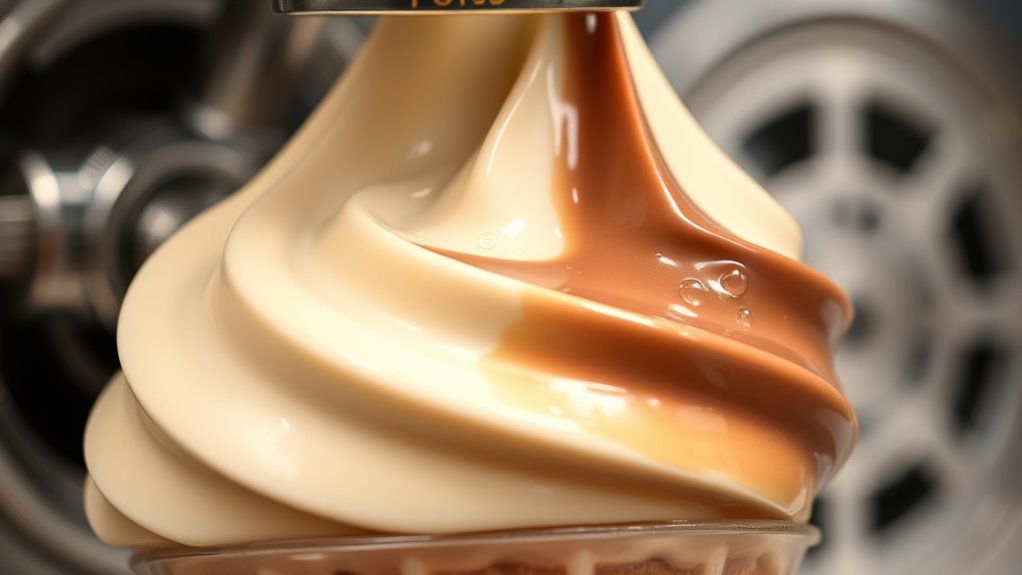
Soft serve machines work by continuously freezing and aerating a liquid mixture to produce a smooth, creamy texture. This process allows you to achieve precise ingredient control, ensuring each serving maintains consistent quality. With advanced systems, you can customize flavors easily, adding syrups or mix-ins to suit your preferences. The machine’s design guarantees ingredient precision, so the texture and taste stay uniform every time. As the mixture moves through the freezing chamber, it’s whipped to incorporate air, resulting in that light, airy consistency you love. This continuous process means your soft serve remains fresh and ready to serve without long wait times. Additionally, the design and operation of these machines often involve calibrated components that help maintain consistent quality throughout multiple servings. Proper maintenance and regular calibration of temperature controls are essential for optimal performance. Overall, soft serve machines give you the flexibility to craft personalized treats with reliable ingredient control and perfect texture.
The Mechanics Behind Batch Freezers
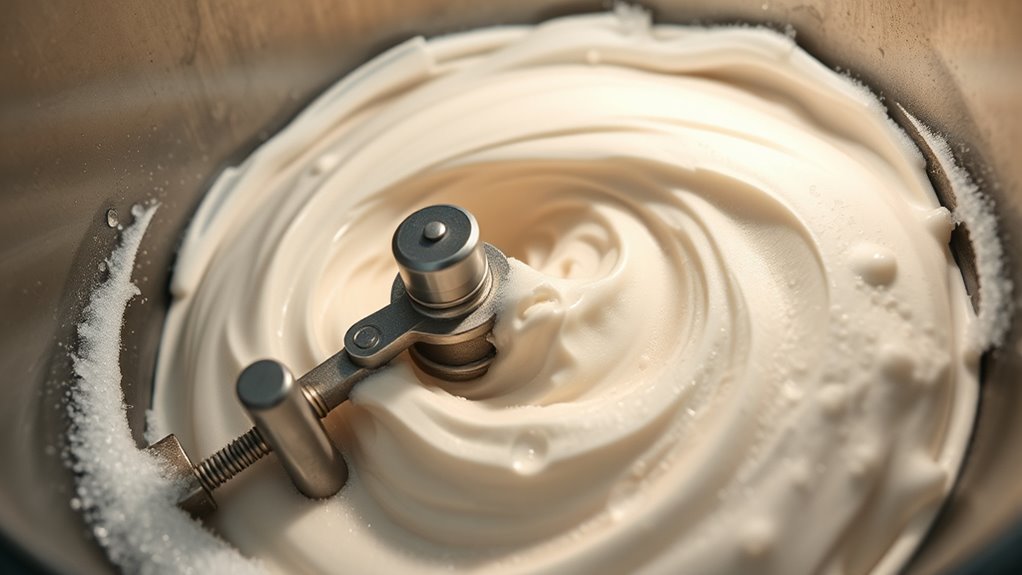
Batch freezers operate by rapidly cooling and churning ice cream or other frozen desserts in large, enclosed containers. This process guarantees a smooth, creamy texture while allowing ample opportunity for flavor infusion, giving each batch a rich, personalized taste. As the mixture freezes, it’s constantly stirred, preventing ice crystal formation and enhancing consistency. Modern batch freezers are designed with energy efficiency in mind, reducing power consumption while maintaining ideal performance. Incorporating good lighting can also enhance the workspace, making it easier to monitor the freezing process and ensure quality. This not only improves visibility but also contributes to energy-efficient operation, helping businesses reduce their environmental impact. Additionally, advancements in appliance technology have allowed for more precise temperature control, resulting in better product quality. Imagine the satisfaction of crafting perfect desserts with precise control over flavor and texture. Feel confident knowing your equipment promotes sustainability without sacrificing quality. Batch freezers open the potential for high-quality, flavorful treats that delight customers, all while conserving energy and reducing operational costs.
Key Differences Between Soft Serve and Batch Freezing
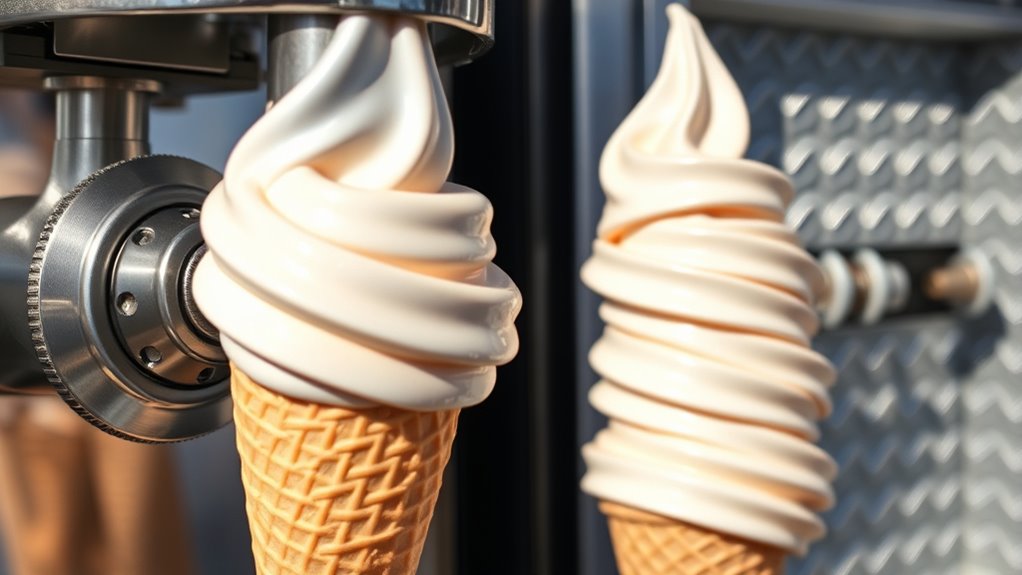
You’ll notice that soft serve and batch freezers differ in how quickly they produce ice cream, affecting your overall operation. Their textures and consistency also vary, influencing customer experience. Additionally, their equipment complexity and costs can impact your setup and maintenance decisions. Understanding the equipment noise levels can help you choose machines that operate quietly, enhancing customer comfort and staff working conditions. Moreover, the freezing process plays a crucial role in determining the final product quality and efficiency of your operation. Proper temperature control is essential for maintaining optimal ice cream texture and preventing spoilage, which is vital for high-quality output. Awareness of industry trends can also guide you in selecting technology that boosts productivity and consistency.
Production Speed Variance
While both soft serve and batch freezers are designed to produce frozen treats efficiently, they differ considerably in their production speeds. Soft serve machines can churn out servings rapidly, making them ideal for high-demand settings. Batch freezers, on the other hand, operate more slowly but prioritize flavor consistency and equipment durability. This means you get a richer, smoother product that maintains quality over time. The faster pace of soft serve may sacrifice some flavor nuances, while batch freezers give you control over every batch. When choosing between them, consider your needs for speed versus quality. Additionally, production speed variance can impact your overall efficiency and customer satisfaction. Understanding the sound frequencies involved in different freezing processes can also offer insights into equipment performance and product quality. Proper maintenance of these machines can also influence their operational speeds, ensuring consistent output and longevity.
Texture and Consistency
Ever wondered how the texture of soft serve differs from that of ice cream made in batch freezers? Soft serve is typically smoother and creamier due to its higher air content, giving it a light, fluffy feel. Batch freezer ice cream tends to be denser, with a richer texture influenced by ingredient impacts like fat and stabilizers. These differences also affect flavor variations—soft serve often has a milder taste, while batch ice cream can carry more intense flavors. The production process plays a crucial role in achieving these textural differences. Here’s a quick comparison:
| Aspect | Soft Serve | Batch Freezer Ice Cream |
|---|---|---|
| Texture | Light, airy, smooth | Dense, creamy |
| Ingredient Impact | Higher air, stabilizers | Richer fats, less air |
| Flavor Variations | Milder, less pronounced | More intense, varied flavors |
| Consistency | Uniform, easy to scoop | Thicker, more solid |
Understanding the tuning process helps illustrate how different modifications can influence overall performance and texture, similar to how different freezing techniques impact ice cream consistency. Additionally, the choice of ingredients and processing parameters can significantly alter the final product’s texture and flavor, making the understanding of these factors crucial for ice cream makers. Recognizing how freezing techniques influence these qualities can help producers optimize their recipes for desired outcomes. Proper freezing control is essential for creating the perfect soft serve or batch ice cream, depending on the desired end result.
Equipment Complexity and Cost
Soft serve machines are generally simpler and more affordable than batch freezers, making them a popular choice for smaller operations or setups with limited space. They require less technical expertise to operate and maintain, which keeps initial costs lower. In contrast, batch freezers involve a costly investment, with complex components that demand skilled technicians for installation and upkeep. The equipment’s intricate design means you’re paying for durability, precision, and versatility—but it’s a significant expense. Additionally, diverse designs in batch freezers allow for customization but can add to the complexity and cost of the equipment. This often requires comprehensive understanding of safety standards and proper maintenance procedures to ensure optimal performance. Proper filter replacement and routine cleaning are essential for maintaining air purifier efficiency and prolonging lifespan, further influencing costs and upkeep.
- Feel confident with easy-to-use machinery that fits your budget and skill level
- Avoid the stress of costly repairs from complicated equipment
- Enjoy the peace of mind knowing your investment is reliable and manageable
Common Myths and Misconceptions
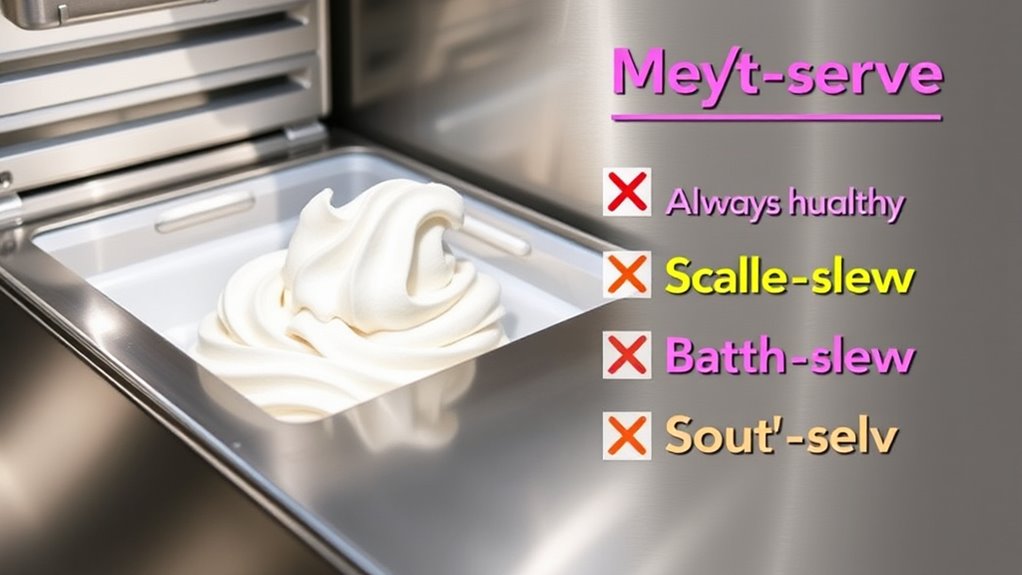
Many people believe that harder ice cream is always better, but that’s not true. You might think batch freezers are only for large-scale operations, yet they come in sizes perfect for smaller setups too. Forsale 100 can also be a resource for purchasing equipment and supplies suitable for various business sizes. Additionally, the quality of ice cream depends on proper freezing techniques and ingredients, not just the hardness. It’s important to understand that pregnancy symptoms and proper handling can also influence the final product quality, especially when considering food safety standards. Let’s clear up these common myths so you can make informed choices about your equipment.
Myth: Harder Means Better
A common misconception is that harder ice cream always indicates better quality or superior texture. In reality, texture differences depend on factors like ingredients and storage, not just firmness. You might think that a denser, harder product shows better equipment durability, but that’s not always true. Overworking or improper freezing can lead to a tough, icy consistency, which customers dislike.
- Harder ice cream can mask poor quality ingredients, not superior craftsmanship.
- Excessive hardness may make scooping more difficult, frustrating customers.
- Relying on firmness as a quality indicator ignores the importance of proper texture balance.
Misconception: Batch Freezers Only Large
Some assume that batch freezers are only suitable for large-scale operations, but in reality, they come in a variety of sizes to fit different business needs. Whether you’re running a small shop, catering to home use appliances, or interested in small scale production, there’s a batch freezer for you. These machines range from compact units perfect for limited space to larger models for higher output. Visualize these options:
| Size | Suitable For | Capacity |
|---|---|---|
| Small | Home use appliances | Low volume |
| Medium | Small cafes, shops | Moderate output |
| Large | Commercial establishments | High volume |
| Compact | Personal or small business | Limited production |
| Industrial | Large-scale production | Massive capacity |
This variety guarantees you don’t need a giant machine to produce quality ice cream or soft serve.
Factors Influencing Ice Cream Quality
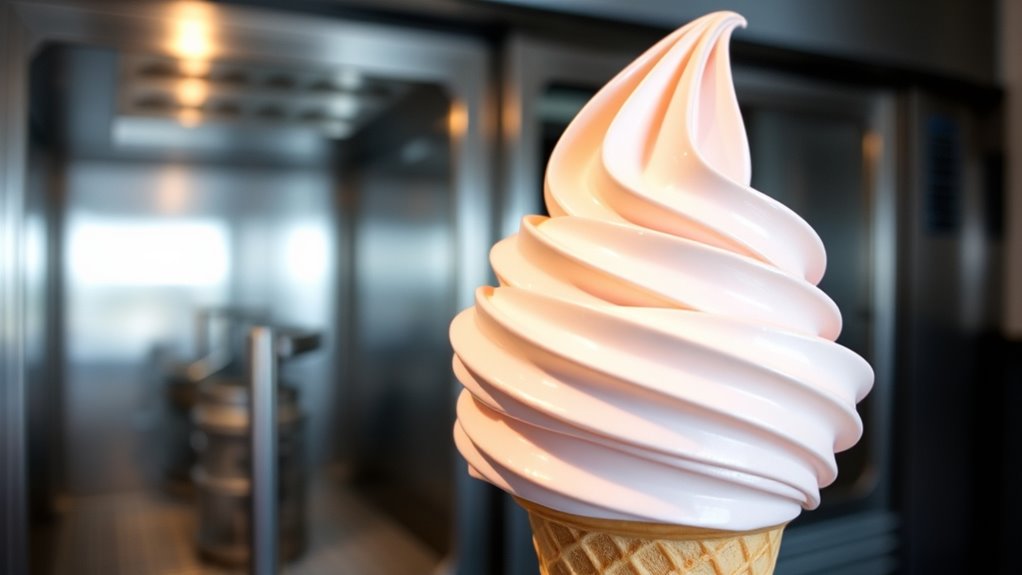
What truly determines the quality of ice cream you enjoy? It’s a mix of factors, but key among them are flavor customization and ingredient sourcing. When you choose high-quality ingredients and customize flavors to your liking, your ice cream becomes more than just a treat — it’s an experience. The freshness of ingredients impacts creaminess and richness, while thoughtful flavor choices evoke emotion and nostalgia.
Consider these factors:
- Ingredient sourcing: Fresh, local ingredients make a noticeable difference.
- Flavor customization: Personal touches create unique, memorable tastes.
- Processing techniques: Proper freezing and churning preserve texture and consistency.
Choosing the Right Equipment for Your Needs
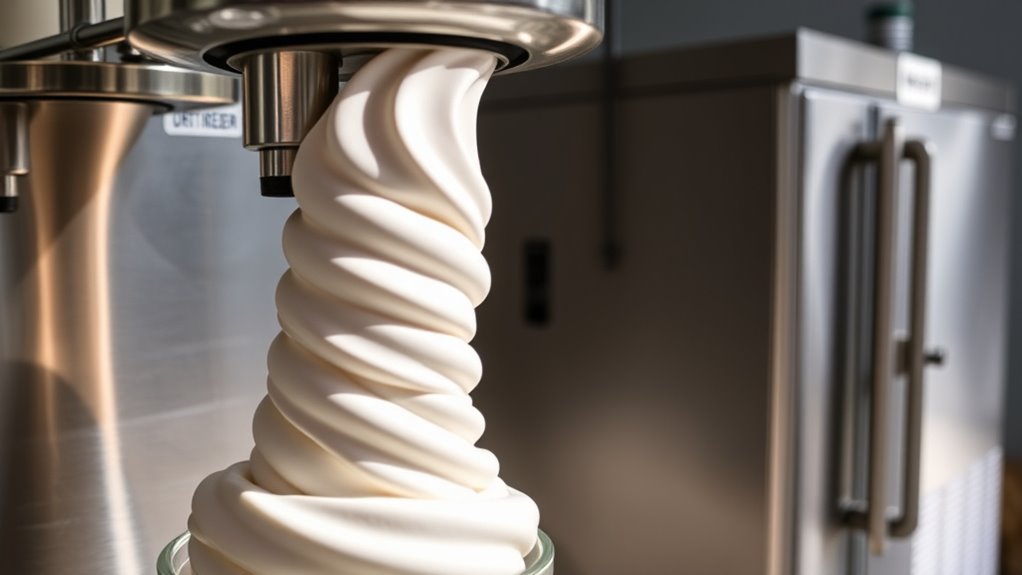
Choosing the right equipment directly impacts the quality and efficiency of your ice cream production. To meet your needs, consider options that support flavor customization and energy efficiency. Soft serve machines excel at quick service, while batch freezers offer more control over texture and flavors. Use this comparison to guide your choice:
| Feature | Soft Serve Machines | Batch Freezers | Both |
|---|---|---|---|
| Flavor customization | Limited | Extensive | Yes |
| Energy efficiency | Moderate | High | Varies |
| Production speed | Fast | Moderate | Depends |
| Ease of use | Simple | More involved | Varies |
| Maintenance | Less demanding | More demanding | Both possible |
Select equipment aligned with your goals for flavor variety and energy savings.
Maintenance and Troubleshooting Tips
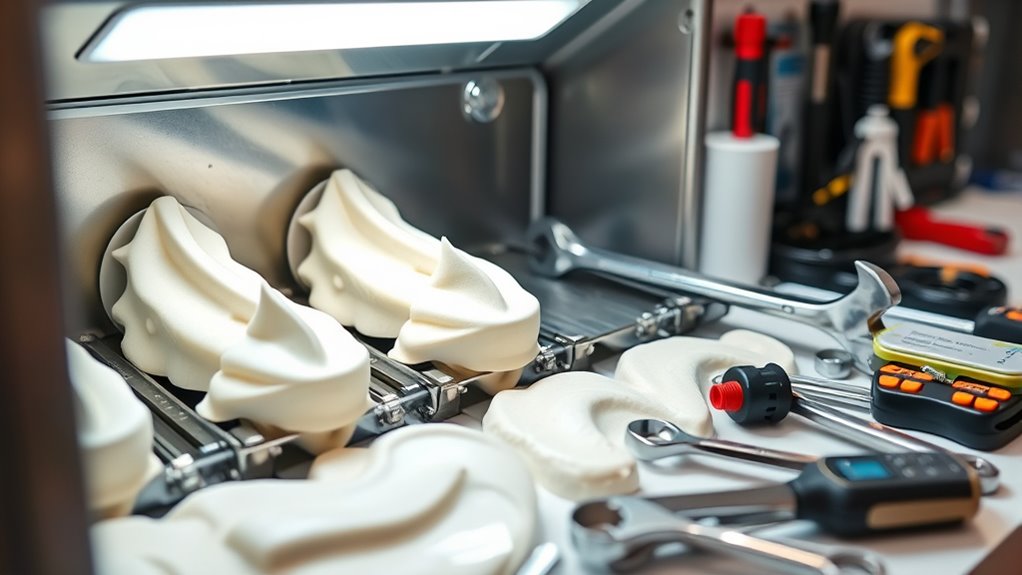
Regular maintenance is essential to keep your soft serve and batch freezers running smoothly and to prevent costly breakdowns. Sticking to strict cleaning schedules ensures that ice buildup and residue don’t cause issues, preserving product quality and equipment lifespan. Make sure to follow lubrication tips, applying food-grade lubricants to moving parts to reduce wear and noise. Troubleshooting common problems quickly can save you time and money—listen for unusual noises, check for temperature inconsistencies, and verify that all components are functioning properly.
Regular maintenance ensures optimal performance and longevity of your freezers.
- Keep your equipment spotless to avoid contamination and operational hiccups.
- Regularly lubricate parts to prevent friction and breakdowns.
- Address issues immediately to minimize downtime and extend your freezers’ life.
Future Trends in Frozen Dessert Technology
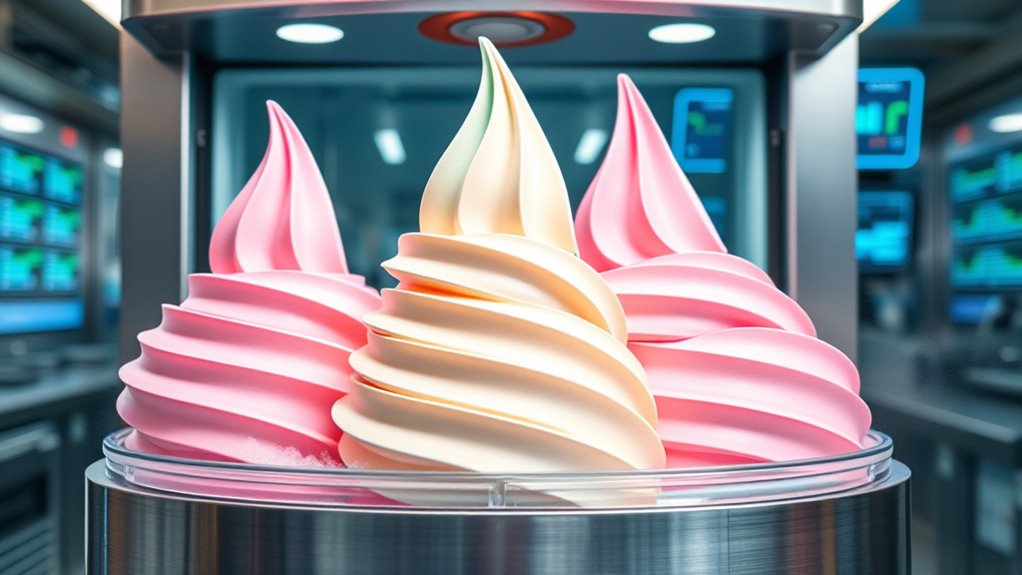
Advancements in frozen dessert technology are poised to revolutionize how you create and serve treats, building on the foundation of reliable equipment maintenance. Expect sustainable innovations to become central, helping you reduce energy consumption and minimize waste. New materials and eco-friendly refrigerants will make your equipment more environmentally friendly. Digital control systems are also transforming operations, providing precise temperature regulation, real-time monitoring, and remote adjustments. These smart features enhance consistency and efficiency, saving you time and resources. Future trends focus on integrating sustainability with advanced automation, making your processes more eco-conscious and user-friendly. As technology evolves, you’ll have greater control over your frozen desserts, ensuring high quality while also supporting environmental responsibility. Staying ahead means embracing these innovations for a more efficient and sustainable future.
Frequently Asked Questions
How Long Does It Take to Freeze Ice Cream in Batch Freezers?
Freezing time in batch freezers usually takes about 20 to 30 minutes, depending on the machine’s size and ingredients. During this process, you might notice some flavor impact if the ice cream isn’t frozen evenly or too quickly. To guarantee the best quality, monitor the freezing time closely and avoid rushing it, so your ice cream remains smooth, flavorful, and perfectly frozen for serving.
Can Soft Serve Machines Produce Traditional Ice Cream?
You might find it tempting to believe soft serve machines can produce traditional ice cream, but they’re really more suited for a smooth, creamy treat. Their dairy content and flavor stability are optimized for soft serve textures, not the denser, richer profile of traditional ice cream. While you can adapt some recipes, true ice cream generally requires different equipment to achieve the desired consistency and flavor depth.
What Are the Energy Consumption Differences Between Soft Serve and Batch Freezers?
You might wonder about the energy efficiency and power consumption differences between soft serve and batch freezers. Soft serve machines typically consume more power because they continuously operate to maintain a smooth, ready-to-serve texture. Batch freezers, on the other hand, are more energy-efficient since they run intermittently during each batch, reducing overall power consumption. Your choice depends on your operational needs and focus on energy savings.
Are There Health Benefits to Choosing Soft Serve Over Traditional Ice Cream?
You might wonder if choosing soft serve over traditional ice cream offers health benefits. Soft serve often has lower dairy content, which can be easier on your digestion, especially if you’re lactose sensitive. Plus, it tends to have fewer additives, reducing additive effects that some people prefer to avoid. However, always check the ingredients, as formulations vary, and moderation remains key for overall health.
How Do Different Flavors Impact the Freezing Process?
Different flavors can impact the freezing process because they cause flavor consistency and freezing point variations. You might notice that fruit-based or alcohol-infused flavors freeze differently, affecting texture and creaminess. These variations make it important to observe your batch freezer closely. By adjusting temperature settings or ingredients, you can guarantee each flavor maintains the desired consistency, giving you a smoother, more consistent soft serve experience every time.
Conclusion
Understanding the differences between soft serve machines and batch freezers helps you make informed choices for your business. For example, opting for a batch freezer might be ideal if you want rich, premium ice cream, while soft serve machines are perfect for quick service. By selecting the right equipment and maintaining it properly, you guarantee consistent quality and customer satisfaction. Stay updated on new technologies to keep your offerings fresh and competitive.



